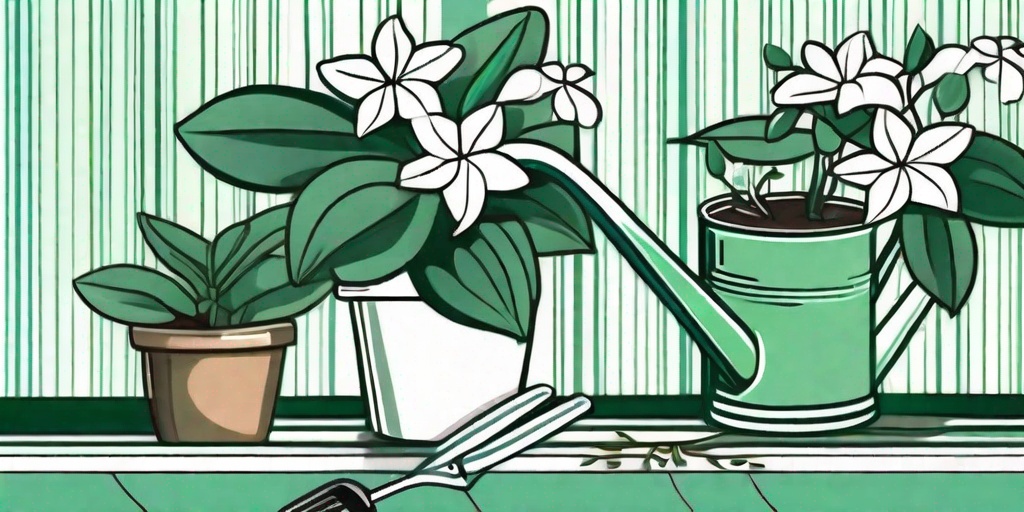
Are you tired of your garden looking like a scene from a post-apocalyptic movie? Do you want to transform it into a floral paradise that would make even the most seasoned gardener green with envy? Well, you're in luck! Today, we're going to talk about a flower that's as exotic as its name sounds - the Stephanotis. Also known as the Madagascar Jasmine or Bridal Veil, this climbing vine is known for its glossy green leaves and fragrant, star-shaped white flowers. So, buckle up, green thumbs, it's time to step up your floral game!
Understanding the Stephanotis
Before we dive into the nitty-gritty of growing and caring for Stephanotis, let's take a moment to appreciate this beauty. Native to Madagascar, the Stephanotis has made its way into hearts and gardens around the world. Its intoxicating fragrance and elegant appearance make it a popular choice for wedding bouquets and floral arrangements.
But don't let its delicate looks fool you. The Stephanotis is a hardy plant that can thrive in a variety of conditions, as long as you give it the right care and attention. And no, you don't need to have a green thumb. With a little patience and our pro tips, you'll have your Stephanotis blooming in no time.
Growing Stephanotis: The Basics
Now that we've piqued your interest, let's get down to business. Growing Stephanotis is not rocket science, but it does require a bit of knowledge and effort. So, let's start with the basics.
First things first, Stephanotis loves the sun. But, like a true diva, it prefers indirect light. So, choose a spot that gets plenty of light but is shielded from the harsh afternoon sun. A window sill with filtered light is perfect.
Next, let's talk about soil. Stephanotis prefers well-drained soil. A mixture of peat moss, perlite, and garden soil should do the trick. Remember, the key is to keep the soil moist but not soggy. Overwatering is a big no-no!
Planting the Stephanotis
Now that you've got the basics down, it's time to get your hands dirty. Planting Stephanotis is a simple process. Start by filling a pot with the soil mixture. Make sure the pot has drainage holes to prevent waterlogging. Next, place the Stephanotis in the pot and cover the roots with soil. Water it thoroughly and place it in a sunny spot. Voila! You've just planted your first Stephanotis.
But remember, planting is just the first step. The real challenge lies in caring for your Stephanotis and helping it thrive.
Caring for Your Stephanotis
So, you've planted your Stephanotis. Now what? Well, now comes the fun part - caring for your plant. This involves watering, feeding, pruning, and more. But don't worry, we've got you covered.
Watering your Stephanotis is a delicate balancing act. You want to keep the soil moist, but not waterlogged. A good rule of thumb is to water your plant when the top inch of soil feels dry. But remember, Stephanotis doesn't like cold water. So, always use room-temperature water.
Feeding your Stephanotis is equally important. Use a balanced fertilizer every two weeks during the growing season. But be careful not to overfeed your plant. Too much fertilizer can do more harm than good.
Pruning and Training Your Stephanotis
Pruning is an essential part of Stephanotis care. It helps your plant maintain its shape and promotes healthy growth. The best time to prune your Stephanotis is in the spring, just before the growing season starts. Cut back any dead or diseased branches and any that are growing out of shape.
Training your Stephanotis is also important. Remember, it's a climbing vine. So, provide a trellis or a similar support for your plant to climb on. This will not only help your plant grow better but also add a touch of elegance to your garden or home.
Common Problems and How to Solve Them
Like all plants, Stephanotis can be prone to certain problems. But don't worry, most of these are easy to solve.
One common problem is yellowing leaves. This is usually a sign of overwatering. If you notice this, cut back on watering and make sure your plant is draining properly.
Another common problem is pests. Aphids, mealybugs, and spider mites can all be a nuisance. But a simple solution of water and mild soap should keep them at bay.
Frequently Asked Questions
Is Stephanotis easy to grow?
Yes, with the right care and conditions, Stephanotis is relatively easy to grow. It requires a sunny spot, well-drained soil, and regular watering and feeding.
Why is my Stephanotis not blooming?
There could be several reasons for this. It could be due to insufficient light, overwatering, or lack of nutrients. Make sure your plant is getting enough light, the soil is well-drained, and you're feeding it regularly.
Can I grow Stephanotis indoors?
Yes, Stephanotis can be grown indoors. In fact, it makes a great houseplant. Just make sure it gets plenty of light and the temperature stays above 50 degrees Fahrenheit.
Conclusion
So, there you have it - your ultimate guide to growing and caring for Stephanotis. With a little effort and our pro tips, you'll have your garden or home filled with the sweet fragrance of Stephanotis in no time. So, what are you waiting for? It's time to step up your floral game!















